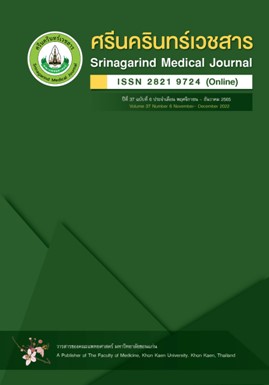Outcomes of Intermediate Care Service in Stroke Rehabilitation Patients at A Hospital in Ubon Ratchathani Province
Keywords:
Stroke, Subacute phase, Intermediate careAbstract
Background and Objective: Stroke is a common, serious, and disabling global health-care problem, and rehabilitation is a major part of patient care. This study aimed to evaluate the outcomes of an intermediate care service, on daily living activities of patients with stroke rehabilitation.
Method: The retrospective cohort study consisted of 35 stroke patients who were discharged from an intermediate care service with intensive rehabilitation training by a multidisciplinary care team. which was proposed in the healthcare system between January 1st, 2020-April 30th, 2022. Barthel index (BI) of Thai version and return to daily living activities are used. Patients get rehabilitation and followed up until reach 6 months. Analyses of the data were to assess: frequencies, percentages, means, and standard deviations of population characteristics and to compare barthel index change with study variables by using chi-square test, paired sample t-test and repeated measurement ANOVA.
Result: The result showed that 51.43% patients were female and average age 56.14±13.98 years, which the most was ischemic stroke 85.71%. The comparison of BI change after discharge in patients who received the intermediate care program was shown statistical significantly increasing of BI (before 6.11±5.78, after 15.43±5.43, mean diff = 9.31, p<0.001), 25.71% of patient was physically independent.
Conclusion: It could be concluded that the patients with stroke, receiving the intermediate care service in a hospital could develop an ability to perform their activities of daily living much better than otherwise
References
Department of thai traditional and alternative medicine. Service guidelines for acupuncture in stroke rehabilitation. Bangkok: Phumthong shop; 2020.
Prasat Neurological Institute. Clinical practice guidelines for stroke rehabilitation. Bangkok: Thanapress company limited; 2014
Strategy and Planning Division of the Permanent Secretary Ministry of Public Health. public health statistics 2017 (online) [cited July 7, 2022]. Available from:http://bps.moph.go.th/new_bps/sites/default/files/stratistics60.pdf.
Tiemkao S. Cerebrovascular disease situation. Neurothai 2021;37(4):54-60.
The Royal College of Physiatrists of Thailand, National Health Security office, Sirindhorn National Medical Rehabilitation Institute. Subacute rehabilitation. Nonthaburi: Association of Rehabilitation Medicine of Thailand; 2016.
Health Administration Division. Guideline for intermediate care (Service Plan). Samut Sakhon: Born to be publishing co; 2019.
Satirangkoon T, Wongsuwansiri S, Kladchompong P. Clinical practice guidelines for intermediate care. Nonthaburi: Nursing division; 2019.
Jutaphutthi A, Siangprasert W, Limsila B, Suttachaiananta T. Service guidelines for acupuncture in stroke rehabilitation. Nonthaburi: Department of thai traditional and alternative medication; 2020.
Hsueh IP, Lee MM, Hsieh CL. Psychometric characteristics of the Barthel activities of daily living index in stroke patients. J Formosan MediAssoc 2001;100(8):526-32.
Hsueh IP, Lin JH, Jeng JS, Hsieh CL. Comparison of the psychometric characteristics of the functional independence measure, 5 item Barthel index, and 10 item Barthel index in patients with stroke. J Neurol Neurosurg Psychiatry 2002;73(2):188-90.
Geraint F. Neurological examination made easy. 2, editor. Edinburgh: Churchill Livingstone; 1999.
Chueluecha C. Rehabilitation in Stroke. Thammasat Med J 2012;12(1):97-111.
Brunnnstrom S. Movement therapy in hemiplegia: A neurophysiological approach. New York: Harper and Row; 1970.
Moonthee W, Monkong S, Sirapongam Y, Leelacharas S. Impact of transitional care programme and family caregivers on stroke patients’ routine activity performance, complications, and satisfaction. J Thai Nurs Midwifery Council 2016;31(1):95-110.
Kwansanit T. Outcomes of Sub-acute rehabilitation program in stroke patient, Suratthani hospital. Reg11 Med J 2017;31(4):723-32.
Suwannachat P, Pansuvannajit P, Jiraporncharoen W. An intermediate care service to improve activities of daily living in patients with stroke, spinal cord injury and traumatic brain injury in Sarapee Borvorn Patthana Hospital, Chiang Mai Province. Lanna Public Health J 2021;17(2):78-89.
Namchandee A. Outcomes of intermediate rehabilitative care in sub-acute stroke patients. Buddhachinaraj Med J 2021;38(3):356-67.
Srisubat A, O-charot L, Loharjun B, Siriwatvejakul U, Kuptniratsaikul V, Opachalermphan S. Cost-effectiveness of intermediate care (inpatient) in post-acute stroke compared with out-patient rehabilitation program. J Diagnostic Med Sonography 2019;44(5):167-73.
Sakulpipatana P. Outcome of Subacute Post-stroke rehabilitation in outpatient-based vs home-based. Reg11 Med J 2021;35(2):1-11.
Chiangchaisakulthai K, Suppradit W, Samipak N. Intermediate Care. Nonthaburi: International Health Policy Program; 2019.
Downloads
Published
How to Cite
Issue
Section
License
Copyright (c) 2022 Srinagarind Medical Journal

This work is licensed under a Creative Commons Attribution-NonCommercial-NoDerivatives 4.0 International License.




